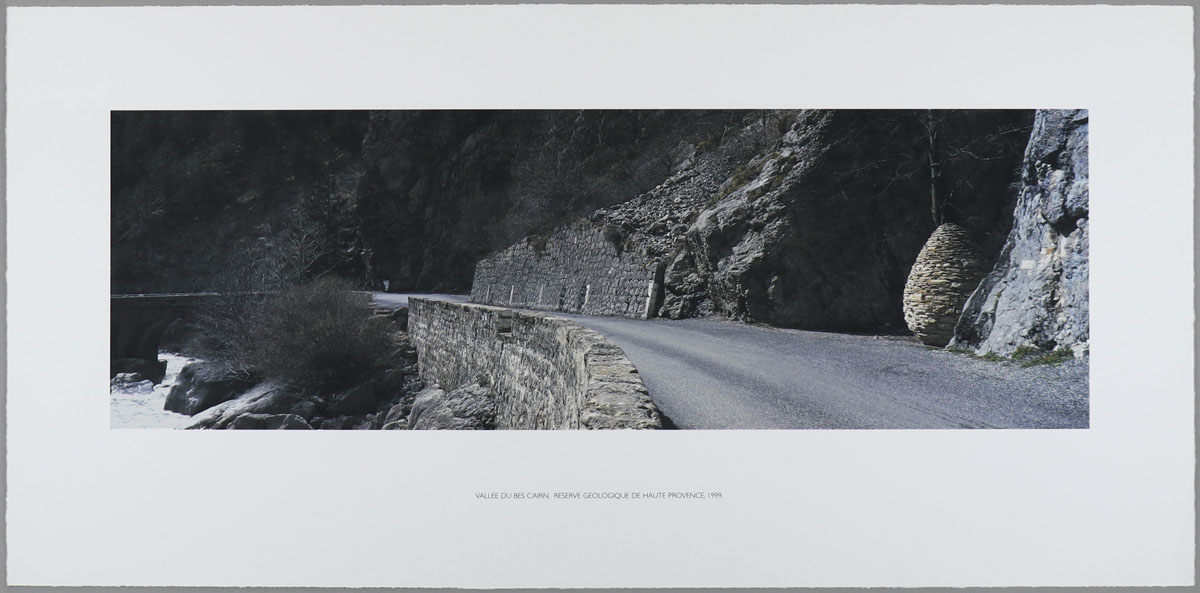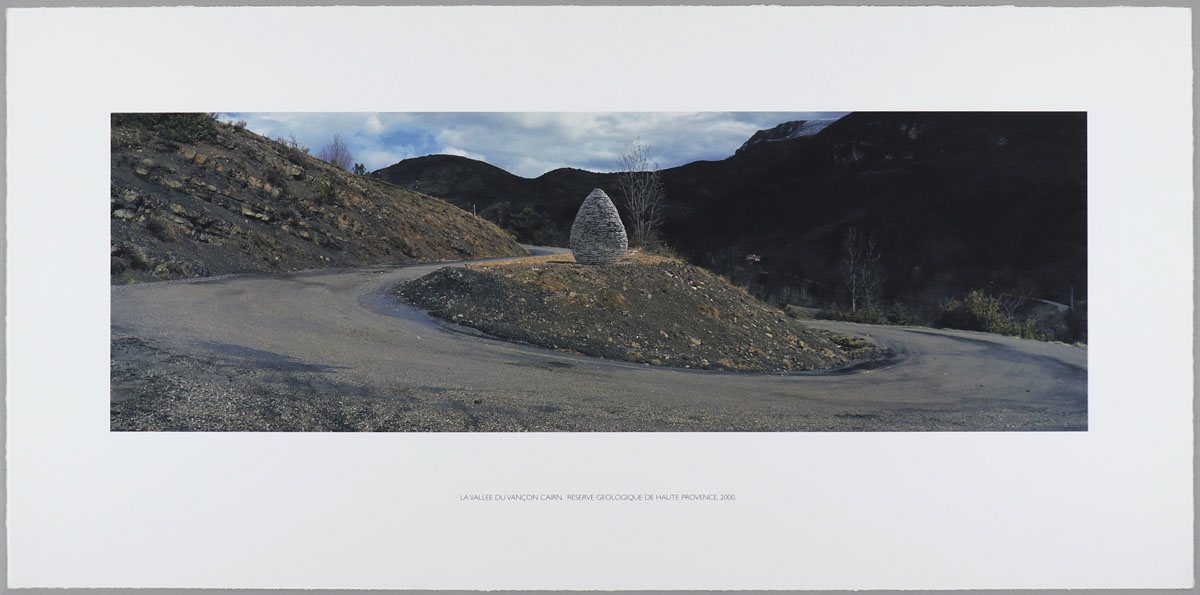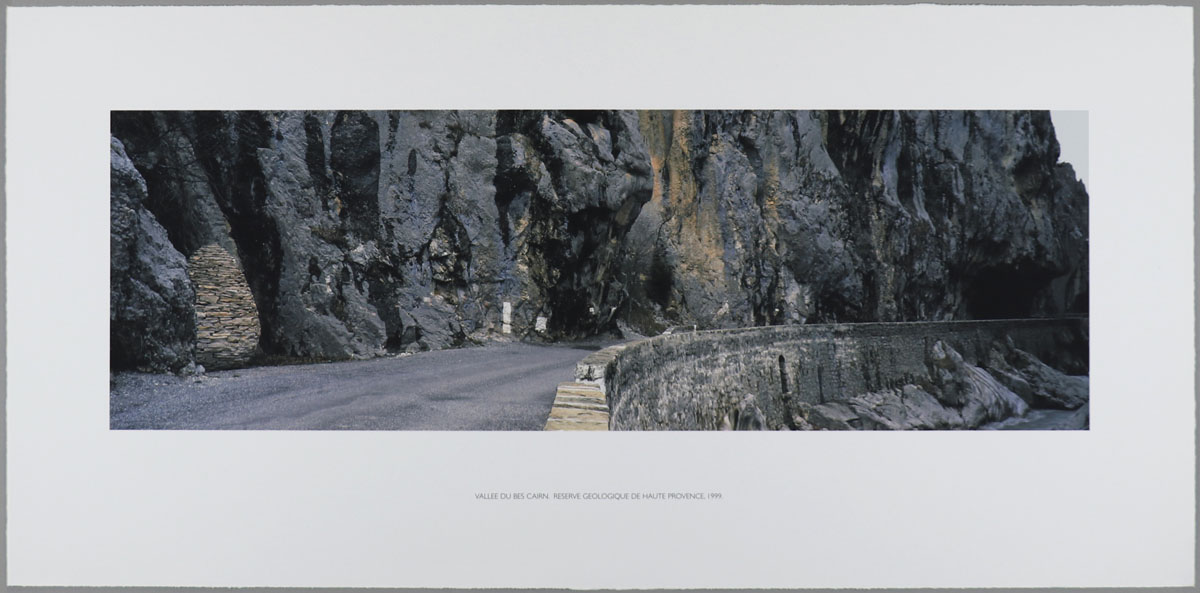Monday 17th July, 1995. Fourth day at Digne. Another bright morning. Worked at the river. Made a small cairn from yellow stones. Making the cairn covered in clay has given me the idea to make a cairn that grows in a way that it changes each day. Each day adding another layer to it. A cairn made up of strata, a geological cairn. Yellow stones that originate from a layer of stone laid down years ago. In the afternoon it was still a bit rough and I had problems constructing the piece. It was going dark, so I had to work quickly - an interesting work. I love the light after the sun has gone down. It is quiet and intense after the bright harshness of the day. Extract from Goldsworthy’s diary
The random and uneven stacks of stones - piled up by farmers at the boundary of their fields in preparation for sowing - had as early as in his twenties been exciting to approach for Goldsworthy. A myriad of questions would race to his mind. One outshining the rest: which sculpture, installation, stone wall - or later, cairn - would be “undiscovered” inside it. Earning a living as an assistant-Waller in the eighties, building and maintaining the historical natural stone fences around Britain, the young Goldsworthy knew that, for obvious reasons, he would always “find” a wall inside. Nevertheless, he always found it intriguing to see what would come from the anonymous pile of rocks. From his mentor he absorbed the knowledge and traditions associated with wall-building and quickly found the many stonewalls he helped to restore almost sculptural. Being present for centuries and constructed from the surrounding natural material, they were twisting and turning their way through the landscape and somehow never seemed to be inflicted upon it. These walls were far more than controlling fences, and had maintained an important bond between nature, people - and sheep.

ANDY GOLDSWORTHY
Vallee du Bes Cairn 1 (June 1999), 2000
Edition of 500
115(w) x 56(h) cm
45.28(w) x 22.05(h) inches

ANDY GOLDSWORTHY
Vallee du Bes Cairn 1 (June 1999), 2000
Edition of 500
115(w) x 56(h) cm
45.28(w) x 22.05(h) inches
|
|
|
115(w) x 56(h) cm
45.28(w) x 22.05(h) inches
|
Iris on Somerset paper with deckled edge
Image size: 94 x 31 cm
Unsigned and unnumbered.
Edition of 500
|
|
During the eighties, Goldsworthy’s liaison with the sculptural walls kept developing. A degree from Lancaster Art College opened new doors and one of his first commissions was a sheepfold in Dumfriesshire in Scotland. The constraints of the fold - that to some extent served a well-defined purpose of keeping the sheep inside - was entirely set free in the next project. In this project the artist decided not to keep the stonewall in a short leach. Instead, the sculptural wall was a rebuilt of a neglected wall within the Grizedale Forest in the Lake District of England. Winding its ways through the forest scenery, sometimes around trees and up-and-down ditches, it became known to the locals as the ‘Wall That Went For a Walk’.
By the turn of the century, Goldsworthy had already been reflecting for some time to create a sculpture formed as a cairn - and when approached by the village he lived in to make a sculpture, this seemed like the perfect opportunity. The moulded form of the cairn, somewhat shaped like an egg, would be a compelling landmark. Just like the stonewalls served as a memorial of the historical bond between people, sheep and nature, the cairn would be the sentinel of the village, reminding the locals of the past. The artist’s first cairn was almost too perfect. Placed on a hill in the outskirts of the village of Bruth in Scotland, Goldsworthy realised soon after it was completed that all the main viewpoints in the village - including the main street - lined up with the cairn and intensifying its symbolic value. The affection for the idea was so strong that eight more cairns were raised outside other villages, each cairn placed in a pinfold - a circular enclosure for sheep - using stones from often deserted folds and thereby maintaining the close tie between the cairn and the fold.

ANDY GOLDSWORTHY
La Vallee du Vancon Cairn (April 2000), 2000
Edition of 500
115(w) x 56(h) cm
45.28(w) x 22.05(h) inches

ANDY GOLDSWORTHY
La Vallee du Vancon Cairn (April 2000), 2000
Edition of 500
115(w) x 56(h) cm
45.28(w) x 22.05(h) inches
|
|
|
115(w) x 56(h) cm
45.28(w) x 22.05(h) inches
|
Iris on Somerset paper with deckled edge
Image size: 94 x 31 cm
Unsigned and unnumbered.
Edition of 500
|
|
From Goldsworthy’s many visits and close attachment to Southern France, a large collection of Goldsworthy’s permanent, indoor works and diaries were present at the Museum of Digne and the Reserve Geologique. Not surprisingly the new project that started in the summer of 1995 found its way to the Alpine town, Digne; a village located along the river Bléone, some one-hundred kilometres north-west of Cannes. In this mountainous terrain, the artist worked through the weeks of July and created several cairns from yellow rocks and clay found on the transitional site between the Alps and the plains of Provence. Four years later, Goldsworthy was ready to complete the last three cairns - and as a collection of several sculptures in the area along a circular route around Digne, the artist’s accomplishment was impressive. To a hiker walking in countryside, passing one of the cairns may go unnoticed; the second would create an interest; the third lead to curiosity of what this was all about; and seeing a few more cairns would provoke the viewer to ask questions. Exactly what the artist wanted to achieve.
Placed in the natural environment, Goldsworthy’s pieces not only impact the surroundings by their presence; how they are perceived are also dramatically influenced by the backdrop. The two
Vallee du Bes Cairn 1 and
Vallee du Bes Cairn 2 seem almost overpowered by the grand, assertive mountain wall rising steeply behind them. Withdrawn from the roadside along the river roaring deafeningly opposite, they look small and insignificant, standing out merely due to the yellow colour and peculiar soft, rounded shape of the clay-covered rocks making up the cairns. Comparingly and although similar in size, the third cairn at
La Valle du Vancon stands out as a majestic monument. Rising inside the bend of a hairpin-turn on the road it demands the attention of passers-by.
Conceptually, the cairns in France are all linked to the very first one. In Scotland they are a reminder of the symbiotic day-to-day relationship with nature; and analogously in Digne, where the cairns are monuments to the people who carved the roads out of the mountains to make the region inhabitable.

ANDY GOLDSWORTHY
Vallee du Bes Cairn 2 (June 1999), 2000
Edition of 500
115(w) x 56(h) cm
45.28(w) x 22.05(h) inches

ANDY GOLDSWORTHY
Vallee du Bes Cairn 2 (June 1999), 2000
Edition of 500
115(w) x 56(h) cm
45.28(w) x 22.05(h) inches
|
|
|
115(w) x 56(h) cm
45.28(w) x 22.05(h) inches
|
Iris print on Somerset paper with deckled edge
Image size: 94 x 31 cm
Unsigned and unnumbered.
Edition of 500
|
|
Under the constant influence of meteorological changes, a vital part of Goldsworthy’s practice is to document the process through diaries, notes and photographs. For three decades this has led to several publications such as the early, ‘Rain, Sun, Snow, Hail, Mist, Calm’ (1985), and the more recent retrospective book ‘Ephemeral Works: 2004-2014’ (2015). In 2000, the artist was awarded an OBE by the English monarch. Goldsworthy lives in Scotland.
A first for any of
Andy Goldsworthy’s projects, a diary covering the completion of the last three “guardian” cairns was available online with exclusive participation by Eyestorm in 1999. Through regular contributions, charting the development of the works as they rose in the landscape, the artist expressed his daily highpoints, as well as the frustrations arising from challenging weather conditions, the changing elements and collapsing structures. Three photographic editions were released through Eyestorm in 2001, showing the final cairns as part of the beautiful rocky scenery around Digne. The editions are unsigned and not numbered.
You can find more information about the three photographic editions and see them in further details on
Andy Goldsworthy’s artist page
here.